| Latest | Greatest | Lobby | Journals | Search | Options | Help | Login |
|
|
|
This topic is archived. |
| Home » Discuss » Topic Forums » Sports |
|
| Jack Rabbit
|
Sun May-30-10 05:44 PM Original message |
| The JR Chess Report (May 30): Kamsky win US Championship; Chinese Championships begin in Xinaghua |
|
Edited on Sun May-30-10 05:48 PM by Jack Rabbit
Gata Kamsky Wins US Championship
 Gata Kamsky, a Soviet-born American of Tatar descent, won his first US national championship since the early 1990s Tuesday when he defeated his friend and training partner Yuri Shulman in a rapid Armageddon game in St. Louis. Shulman, who was also born in the old Soviet Union, drew Kamsky the day before in the final round of the quadrangular championship to tie Kamsky for first place. In Tuesday's game, the players started with a base time of 60 minutes, but put in bids of time for the right play Black with the odds of draw (meaning that for Black a draw would be as good as an outright victory). Shulman, not noted for his speed chess skills, all but conceded Black to Kamsky by bidding 40 minutes while Kamsky bid 25, which some commentators thought very low. Shulman played a solid Queen's pawn opening which morphed into a Slav-Grünfeld Defense and appeared to have the upper hand by about the thirtieth move. However, an inaccuracy allowed Kamsky to equalize if not get the better game. On the 66th move Shulman, seeing he could not win the game, agreed to a draw. Kamsky last won the US Championship in 1991. Chinese Championships Begin in Xinghua  The annual Chinese National Chess Championships began Monday in Xinghua in Jiangsu province. The defending champion in the general group is Ding Liren, who last year was untitled but this year competes as a grandmaster. The leaders after six rounds are Bu Xiangzhi and Zhou Jianchao with 4½ points each. Ni Hua and Li Shilong are tied for third with 4 point each. As last year, it is indeed improper to refer to the general group as the "men's group," as Hou Yifan is again playing with the guys. Shen Yang is the defending women's champion. The leaders after six rounds are Huang Qian and Ju Wenjun with five points each, a point and a half ahead of Wang Yu in third place. The event ends after the eleventh round Friday. Beginning this week Karpov International Tournament, Poikovsky 31 May-14 June. Bacrot, Bologan, Jakovenko, Motylev, Onischuk, Rianzantsev, Rublevsky, Shirov, Ivan Sokolov, Sutivsky, Svidler and Wang Hao. Calendar 45th Capablanca Memorial Tournament, Havana 9-22 June. Alekseev, Bruzón, Domínguez, Ivanchuk, Nepomniachtchi and Short. Kings Tournament, Banza 14-24 June. Carlsen, Gelfand, Nisipeanu, Ponomariov, Radjabov and Wang Yue. Women's Grand Prix, Jermuk 23 June-6 July. World Open, Valley Forge, Pennsylvania 29 June-5 July. Sparkassen Chess Meeting, Dortmund 15-25 July. Kramnik, Le Quang Liem, Leko, Mamedyarov, Naiditsch and Ponomariov. Women's Grand Prix, Ulan Bator (Mongolia) 29 July-12 August. World Junior Championships, Chotowa Czarna (Poland) 2-17 August. Mainz Chess Classic 6-8 August. The world economic crisis reduces the festival to three days in 2010, with the rapid open and simultaneous exhibitions by Vishy Anand and Alexandra Kosteniuk being the only featured events. Chess Olympiad, Khanty Mansiysk 19 September-4 October. Pan-American Women's Championship, São Paulo 10-21 October. European Club Cup, Plovdiv 16-24 October. Women's Grand Prix, Vina del Mar (Chile) 27 October-9 November. World Youth Championships, Halidiki (Greece) 19-31 October. FIDE Women's Knock Out (Women's World Championship), Turkey 2-25 December. Games will be posted tomorrow (Memorial Day) |
| Printer Friendly | Permalink | | Top |
| Jack Rabbit
|
Mon May-31-10 01:33 PM Response to Original message |
| 1. This week's games |
|
Your humble hare acknowledges the assistance of Fritz 6.0 on analysis. Diagrams on the Jack Rabbit Chess Report are made with Chess Mérida, a true type font that can be downloaded free here. !""""""""# $tMvWlVmT% $OoOoOoOo% $ + + + +% $+ + + + % $ + + + +% $+ + + + % $pPpPpPpP% $RnBqKbNr% /(((((((() WHITE White to move (This position is a theoretical draw) I would like to thank my impressive and loyal staff: Buccaneer, Spitfire, Swashbuckler, Pancho and Robin Hood. |
| Printer Friendly | Permalink | | Top |
| Jack Rabbit
|
Mon May-31-10 01:34 PM Response to Reply #1 |
| 2. Chinese National Championships, Xinghua |
| Printer Friendly | Permalink | | Top |
| Jack Rabbit
|
Mon May-31-10 01:38 PM Response to Reply #2 |
| 4. Bu Xiangzhi - Lu Shanglei, General Group, Round 5 |
|
As of today (Monday, May 31), Bu Xiangzhi is in first place clear after seven rounds.
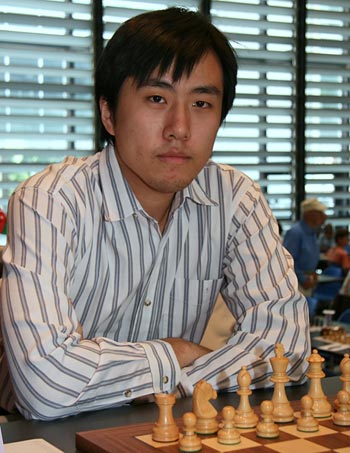 Bu Xiangzhi Bu Xiangzhi - Lu Shanglei Chinese National Championships, General Group, Round 5 Xinghua, 28 May 2010 Semi-Slav Queen's Gambit: Marshall Opening 1.c4 c6 2.e4 e6 3.d4 d5 4.Nc3 dxe4
5.Nxe4 Bb4+ 6.Bd2 Qxd4 7.Bxb4 Qxe4+ 8.Be2 Qxg2
9.Qd6 Nd7 10.0-0-0 Qxf2!?
11.Bf3
11...Qe3+ 12.Kb1 Qe5 13.Qd3 Ngf6 14.Nh3
14...c5 15.Bc3 Qf5 16.Qxf5 exf5 17.Rhe1+
17...Kf8 18.Nf4 h5!?
19.b4 Rh6!?
20.bxc5!?
20...Ne4?!
""""""""# $t+v+ L +% $Oo+m+oO % $ + + + T% $+ P +o+o% $ +p+mN +% $+ B +b+ % $p+ + + P% $+k+rR + % /(((((((() WHITE: Bu Xiangzhi Position after 20...Nf6e4 21.Bxe4!
21...fxe4 22.Rxe4 g5?
23.Rde1!
23...Nf6
24.Bxf6 Bf5
25.Bxg5 Rc6
26.Be7+ Kg8
""""""""# $t+ + +l+% $Oo+ Bo+ % $ +t+ + +% $+ P +v+o% $ +p+rN +% $+ + + + % $p+ + + P% $+k+ R + % /(((((((() WHITE: Bu Xiangzhi Position after 26...Kf8g8 27.Kb2!!
27...Bxe4 28.Rxe4 Re8 29.Nd5 b6 30.Re5 1-0
|
| Printer Friendly | Permalink | | Top |
| Jack Rabbit
|
Mon May-31-10 01:42 PM Response to Reply #2 |
| 5. Lu Shanglei - Zhou Jianchao, General Group, Round 4 |
 Zhou Jinachao Lu Shanglei - Zhou Jianchao Chinese National Championships, General Group, Round 4 Xinghua, 27 May 2010 Open Sicilian Game: Scheveningen Defense (Keres Opening) 1.e4 c5 2.Nf3 e6 3.d4 cxd4 4.Nxd4 Nf6 5.Nc3 d6 6.g4 h6
7.g5
7...hxg5 8.Bxg5 Nc6 9.Qd2 Qb6 10.0-0-0
10...Qxd4 11.Qxd4 Nxd4 12.Rxd4 a6 13.h4 Bd7 14.Bg2
14...Bc6 15.Re1!?
15...0-0-0
16.a4 Kb8 17.f4!?
17...Re8!?
18.Rf1 Nh7 19.f5
19...Nxg5 20.hxg5 Be7 21.f6!
21...gxf6 22.gxf6 Bf8 23.Rf3!?
23...Bh6+!?
24.Kb1!?
""""""""# $ L +t+ T% $+o+ +o+ % $o+vOoP V% $+ + + + % $p+ Rp+ +% $+ N +r+ % $ Pp+ +b+% $+k+ + + % /(((((((() WHITE: Lu Shanglei Position after 24.Kc1b1 24...Reg8!
25.Bf1 Bf8!?
26.b4!
26...Bd7 27.b5
27...a5 28.b6 Bc6 29.Bb5
29...Rg5 30.Rc4!?
""""""""# $ L + V T% $+o+ +o+ % $ PvOoP +% $Ob+ + T % $p+r+p+ +% $+ N +r+ % $ +p+ + +% $+k+ + + % /(((((((() WHITE: Lu Shanglei Position after 30.Rd4c4 30...d5!
31.exd5 exd5 32.Rxc6 bxc6 33.Bxc6 d4!
34.Nd5 Bc5 35.b7!?
""""""""# $ L + + T% $+p+ +o+ % $ +b+ P +% $O Vn+ T % $p+ O + +% $+ + +r+ % $ +p+ + +% $+k+ + + % /(((((((() WHITE: Lu Shanglei Position after 35.b6b7 35...Rd8!
36.Ne7 Re5 37.Rb3?
37...Bxe7 38.fxe7 Rxe7 39.Rb5
""""""""# $ L T + +% $+p+ To+ % $ +v+ + +% $Or+ + + % $p+ O + +% $+ + + + % $ +p+ + +% $+k+ + + % /(((((((() WHITE: Lu Shanglei Position after 39.Rb3b5 39...Rd6 40.Bf3 Rf6 41.Bg2
41...Re2 42.Bd5 d3 43.Rxa5 dxc2+! 0-1
|
| Printer Friendly | Permalink | | Top |
| Jack Rabbit
|
Mon May-31-10 01:43 PM Response to Reply #2 |
| 6. Shen Yang - Ju Wenjun, Women's Group, Round 3 |
|
As of today (Monday, May 31), Ju Wenjun is in first place clear after winning her seventh round game over Zhang Xiaowen.
 Ju Wenjun Shen Yang - Ju Wenjun Chinese National Championships, Women's Group, Round 3 Xinghua, 26 May 2010 West India Game: King's Indian Defense (Main Line) 1.d4 Nf6 2.Nf3 g6 3.c4 Bg7 4.Nc3 0-0 5.e4 d6 6.Be2 e5 7.Be3 Ng4
8.Bg5 f6 9.Bh4 Nc6
10.d5 Ne7 11.Nd2 Nh6 12.f3 c5 13.Rb1
13...g5
14.Bf2 f5 15.b4
15...b6 16.a4!?
16...Ng6
""""""""# $t+vW Tl+% $O + + Vo% $ O + +mM% $+ OpOoO % $pPp+p+ +% $+ N +p+ % $ + NbBpP% $+r+qK +r% /(((((((() WHITE: Shen Yang Position after 16...Nd7g6 17.g3
17...g4 18.a5 gxf3 19.Bxf3 fxe4 20.Ndxe4 Bh3
21.a6 cxb4 22.Rxb4 Qd7 23.Be3!?
23...Qf5!?
24.Be2?!
""""""""# $t+ + Tl+% $+ + + Vo% $ + O +mM% $+ +pOw+ % $ Rp+n+ +% $+ N B Pv% $ + +b+ P% $+ +qK +r% /(((((((() WHITE: Shen Yang Position after 24.Bf3e2 24...Bg2!
25.Rg1 Qh3
26.Nxd6 Qxh2 27.Kd2 Qxg3
28.c5 bxc5 29.Rb7
29...Qh2
30.Kc1?
30...e4!?
31.Ncxe4!?
31...Bxe4! 32.Nxe4 Nf5 33.Bxc5?
""""""""# $t+ + Tl+% $Or+ + Vo% $p+ + +m+% $+ Bp+m+ % $ + +n+ +% $+ + + + % $ + +b+ W% $+ Kq+ R % /(((((((() WHITE: Shen Yang Position after 33.Be3c5:p 33...Qf4+!
34.Nd2
34...Rac8 35.Qc2 Nd4!
36.Rf1
36...Nxc2 37.Rxf4 Rxf4 38.d6
38...Rxc5 39.d7 Bf6 40.Rb8+ Kg7 41.Rc8 Rd5 0-1
|
| Printer Friendly | Permalink | | Top |
| Jack Rabbit
|
Mon May-31-10 01:45 PM Response to Reply #2 |
| 7. Zhao Xue - Huang Qian, Women's Group, Round 6 |
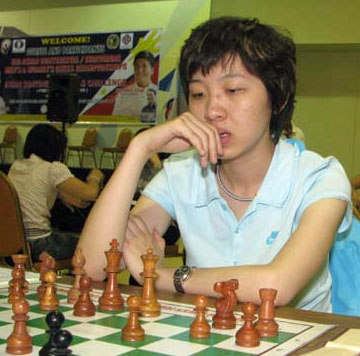 Huang Qian Zhao Xue - Huang Qian Chinese National Championships, Women's Group, Round 6 Xinghua, 29 May 2010 West India Game: King's Indian Defense (Main Line) 1.d4 Nf6 2.c4 g6 3.Nc3 Bg7 4.e4 d6 5.Be2 0-0 6.Nf3 e5 7.0-0 Nc6 8.d5 Ne7 9.Nd2 a5 10.a3 Bd7 11.b3 c6 12.Ra2
12...c5!?
13.Bb2
13...Nc8!?
14.b4!
14...axb4
15.axb4 Rxa2 16.Nxa2 b6
17.Bc3 Ne8 18.Qc2!?
""""""""# $ +mWmTl+% $+ +v+oVo% $ O O +o+% $+ OpO + % $ Pp+p+ +% $+ B + + % $n+qNbPpP% $+ + +rK % /(((((((() WHITE: Zhao Xue Position after 18.Qd1c2 18...f5!
19.Rb1
19...Nf6!
20.bxc5 bxc5 21.Rb7 fxe4 22.Nxe4 Nxe4 23.Qxe4 Bf5
24.Qe3 Ne7 25.Qd2 Bc8 26.Ba5 Qe8
27.Ra7 Nf5 28.Nc3 e4 29.Nb5 e3
30.fxe3 Bh6
31.Kh1 Bxe3 32.Qe1 Qe4 """"""""# $ +v+ Tl+% $R + + +o% $ + O +o+% $BmOp+m+ % $ +p+w+ +% $+ + V + % $ + +b+pP% $+ + Q +k% /(((((((() WHITE: Zhao Xue Position after 32...Qe8e4 33.Bf3?
33...Qxc4!
34.Nxd6 Nxd6 35.Qxe3 Qf1+ 36.Qg1 """"""""# $ +v+ Tl+% $R + + +o% $ + M +o+% $B Op+ + % $ + + + +% $+ + +b+ % $ + + +pP% $+ + +wQk% /(((((((() WHITE: Zhao Xue Position after 36.Qe3g1 36...Rxf3!!
37.gxf3 Qxf3+ 38.Qg2 Qd1+ 39.Qg1 Qxd5+ 40.Qg2 Qd1+ 41.Qg1 """"""""# $ +v+ +l+% $R + + +o% $ + M +o+% $B O + + % $ + + + +% $+ + + + % $ + + + P% $+ +w+ Qk% /(((((((() WHITE: Zhao Xue Position after 41.Qg2g1 41...Bb7+!
42.Rxb7 Qxg1+ 43.Kxg1 Nxb7 44.Bc7 Kf7!
45.Kf2 Ke6 46.Kf3
46...Nd6 47.Kf4 c4 48.Ba5 h6 49.Bc3
49...g5+ 50.Kg4 Ne4 51.Bg7 c3 0-1
|
| Printer Friendly | Permalink | | Top |
| Jack Rabbit
|
Mon May-31-10 01:47 PM Response to Reply #2 |
| 8. Wang Hao - Ding Liren, General Group, Round 1 |
|
The opening round featured a battle between the defending champion, Ding Liren, and last year's runner up.
Wang Hao Wang Hao - Ding Liren Chinese National Championships, General Group, Round 1 Xinghua, 24 May 2010 West India Game: King's Indian Defense (Catalan Opening) 1.d4 Nf6 2.c4 g6 3.g3 Bg7 4.Bg2 0-0 5.Nc3 d6 6.Nf3 Nc6 7.0-0 a6 8.b3 Rb8 9.Nd5 Nd7
10.e4
10...e6
11.Ne3 Nc5 """"""""# $ TvW Tl+% $+oO +oVo% $o+mOo+o+% $+ M + + % $ +pPp+ +% $+p+ NnP % $p+ + PbP% $R Bq+rK % /(((((((() WHITE: Wang Hao Position after 11...Nd7c5 12.dxc5!
12...Bxa1 13.cxd6 Bc3 14.Ba3 Bb4
15.Bxb4 Nxb4 16.e5 Nc6!?
17.Qd2!?
""""""""# $ TvW Tl+% $+oO +o+o% $o+mPo+o+% $+ + P + % $ +p+ + +% $+p+ NnP % $p+ Q Pbp% $+ + +rK % /(((((((() WHITE: Wang Hao Position after 17.Qd1d2 17...cxd6!
18.exd6 e5 19.Rd1 Be6 20.h4
20...f6 21.c5 b6 22.d7
22...Rf7 23.Qd6 Qxd7 24.Ng5 fxg5 25.Bxc6 Qxd6
26.Rxd6 Re7 27.cxb6 gxh4 28.gxh4 a5!?
29.Nc4!
29...Kf8 30.Bd5 Rd7 31.Rxe6 Rxd5 """"""""# $ T + L +% $+ + + +o% $ P +r+o+% $O +tO + % $ +n+ + P% $+p+ + + % $p+ + P +% $+ + + K % /(((((((() WHITE: Wang Hao Position after 31...Rd7d5:B 32.Kg2!?
32...Rb5 33.Rc6!?
33...Kg7!?
34.Rc7+!
34...Kh6 35.Ra7!?
35...e4!
36.Re7 Rb4 37.Ra7
37...Rb5 38.Kg3 g5
39.hxg5+ Rxg5+?
""""""""# $ T + + +% $R + + +o% $ P + + L% $O + + T % $ +n+o+ +% $+o+ + K % $o+ + P +% $+ + + + % /(((((((() WHITE: Wang Hao Position after 39...Rb5g5:p 40.Kf4!
40...Rg2
41.Kxe4
41...Rxf2 42.Rxa5 Kg7 43.Ra7+ Kg8
44.b7 Rf7 45.Nd6 Rd7 46.Kd5 Kf8
47.Kc6 Ke7 48.Ne4 h5
49.Nc5 Rd4 50.Kc7 Rbd8 51.Ra8 h4 52.Rc8 R4d5 53.b4 1-0
|
| Printer Friendly | Permalink | | Top |
| Jack Rabbit
|
Mon May-31-10 01:49 PM Response to Reply #2 |
| 9. Zhou Weiqi - Hou Yifan, General Group, Round 3 |
 Hou Yifan Zhou Weiqi - Hou Yifan Chinese National Championships, General Group, Round 3 Xinghua, 26 May 2010 Grand Orthodox Queen's Gambit: Nimzo-Ragozin Defense 1.d4 e6 2.c4 d5 3.Nf3 Nf6 4.Nc3 Bb4 5.cxd5
5...exd5 6.Bg5 h6
7.Bxf6
7...Qxf6 8.Qb3
8...c5 9.dxc5
9...Bxc3+
10.bxc3 0-0 11.Nd4 Be6 12.Qxb7!?
12...Nd7
13.c6 Rab8 14.Qxa7
14...Ra8 15.Qc7 Ne5 16.e3
16...Rfc8 17.Qb6?!
17...Rcb8 18.Qc5 Rb2 19.f4?
""""""""# $t+ + +l+% $+ + +oO % $ +p+vW O% $+ QoM + % $ + N P +% $+ P P + % $pT + +pP% $R + Kb+r% /(((((((() WHITE: Zhou Weiqi Position after 19.f2f4 19...Rxg2!!
20.0-0-0
20...Rgxa2 21.Be2 Nc4
22.Bxc4 dxc4 23.Rhg1
23...Ra1+ 24.Kd2 R8a2+ 25.Nc2 Rxd1+ 0-1
|
| Printer Friendly | Permalink | | Top |
| Jack Rabbit
|
Mon May-31-10 01:36 PM Response to Reply #1 |
| 3. US National Championships, St. Louis |
| Printer Friendly | Permalink | | Top |
| Jack Rabbit
|
Mon May-31-10 01:52 PM Response to Reply #3 |
| 10. Shulman - Kamsky, Quad Group, Round 3 |
|
Edited on Mon May-31-10 01:54 PM by Jack Rabbit
This was the final game of the Quad, which set up the Armageddon game for the following day.
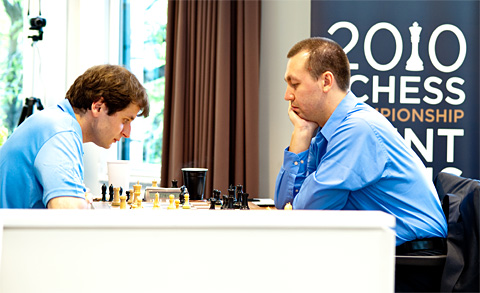 Yuri Shulman and Gata Kamsky Yuri Shulman - Gata Kamsky US Championship, Quad Group, Round 3 St Louis, 24 May 2010 West India Game: Indian Queen's Gambit (Exchange Opening) (Grünfeld Defense) 1.d4 Nf6 2.c4 g6 3.Nc3 d5 4.cxd5 Nxd5 5.e4 Nxc3 6.bxc3 Bg7 7.Nf3 c5 8.Rb1 0-0 9.Be2 Nc6 10.d5 Bxc3+ 11.Bd2
11...Bxd2+ 12.Qxd2 Na5 13.h4 Bg4 14.Ng5
14...Bxe2 15.Kxe2 h6
16.Nf3 Kh7 17.e5!?
17...Nc4!?
18.Qd3 Nb6
""""""""# $t+ W T +% $oO+ Oo+l% $ M + +oO% $+ OpP + % $ + + + P% $+ +q+n+ % $p+ +kPp+% $+r+ + +r% /(((((((() WHITE: Yuri Shulman Position after 18...Nc4b6 19.h5!
19...Qxd5
20.hxg6+ fxg6 21.Ng5+
21...Kg7
22.Qxd5 Nxd5 23.Ne6+ Kf7 24.Nxf8
24...Nc3+!
""""""""# $t+ + N +% $Oo+ Ol+ % $ + + +oO% $+ O P + % $ + + + +% $+ M + + % $p+ +kPp+% $+r+ + +r% /(((((((() WHITE: Yuri Shulman Position after 24...Ne4c3 25.Ke3!
25...Nxb1 26.Rxb1 Rxf8
27.Rxb7 Ke6 28.Rxa7 g5 29.Rc7 Ra8 30.Rxc5 Rxa2 ½-½
|
| Printer Friendly | Permalink | | Top |
| Jack Rabbit
|
Mon May-31-10 01:54 PM Response to Reply #3 |
| 11. Nakamura - Shulman, Quad Group, Round 2 |
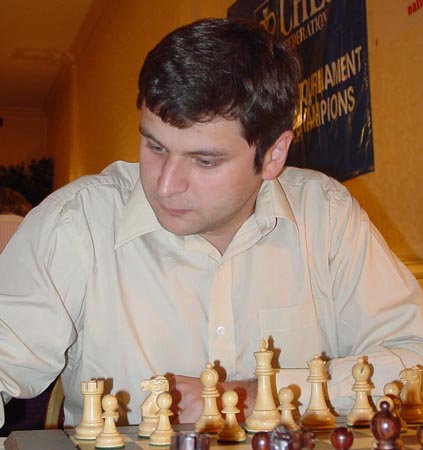 Yuri Shulman Hikaru Nakamura - Yuri Shulman US Championship, Quad Group, Round 2 St Louis, 23 May 2010 Closed French Game: Nimzo-Winawer Defense 1.e4 e6 2.d4 d5 3.Nc3 Bb4 4.e5 c5 5.a3 Bxc3+ 6.bxc3 Qa5 7.Bd2 Qa4 8.Nf3
8...Nc6
9.h4
&& 9...cxd4!?
10.cxd4!?
10...Nge7 11.h5 Nxd4 12.Bd3 h6
13.Kf1 Nxf3 14.Qxf3 b6!?
""""""""# $t+v+l+ T% $O + MoO % $ O +o+ O% $+ +oP +p% $w+ + + +% $P +b+q+ % $ +pB Pp+% $R + +k+r% /(((((((() WHITE: Hikaru Nakamura Position after 14...b7b6 15.Qg3!
15...Ba6 16.Qxg7 Bxd3+ 17.cxd3 Rg8 18.Qxh6
18...Qd4 19.Re1
19...Qxd3+ 20.Kg1 Rc8!? 21.Bg5?!
21...Qf5!
22.f4?
22...Rc2!
23.Rh2 Qd3!
24.Qf6
""""""""# $ + +l+t+% $O + Mo+ % $ O +oQ +% $+ +oP Bp% $ + + P +% $P +w+ + % $ +t+ +pR% $+ + R K % /(((((((() WHITE: Hikaru Nakamura Position after 24.Qh6f6 24...Rxg5!!
25.Qxg5
25...Qd4+ 26.Kh1 Qe3!! 0-1
|
| Printer Friendly | Permalink | | Top |
| Jack Rabbit
|
Mon May-31-10 01:58 PM Response to Reply #3 |
| 12. Shabalov - Stripunsky, Challenge Group, Round 9 |
|
Edited on Mon May-31-10 02:03 PM by Jack Rabbit
Alex Shabalov won the Challenge Group (those who did not qualify for the Quad) with this last round victory. It earned him $10,000. Gata Kamsky, who won the Armageddon game over Yuri Shulman to finish the Quad, took home the title of 2010 US national champion and $30,000.
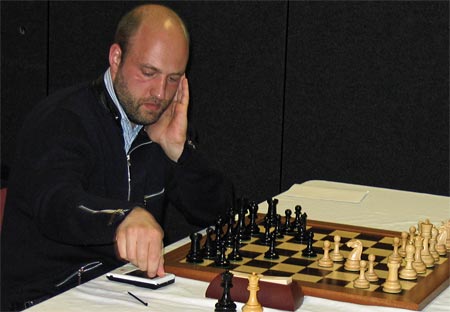 Alex Shabalov Alex Shabalov - Alex Stripunsky US Championship, Challenger Group, Round 9 St Louis, 23 May 2010 Open Sicilian Game: Kan Defense (Polugaevsky Variation) 1.e4 c5 2.Nf3 e6 3.d4 cxd4 4.Nxd4 a6 5.Bd3 Bc5 6.Nb3 Be7 7.Be3
7...d6 8.N1d2 Nf6 9.f4 Nc6 10.c3 b6!?
11.Qf3
11...Qc7 12.0-0 Bb7 13.a4 0-0
14.Nd4!?
14...Nd7!
15.Qh3 Rae8 16.Rf3
16...Nc5 17.Bc2
17...e5!?
""""""""# $ + +tTl+% $+vW VoOo% $oOmo + +% $+ M P + % $p+ NpP +% $+ P Br+q% $ PbN +pP% $R + + K % /(((((((() WHITE: Alex Shabalov Position after 17...e6e5 18.Nf5!
18...Bc8
19.Qh5 Bxf5
20.exf5 e4?
21.Rh3! h6 22.Bxc5 bxc5 23.Nxe4 Qd8
""""""""# $ + WtTl+% $+ + VoO % $o+mO + O% $+ O +p+q% $p+ +nP +% $+ P + +r% $ Pb+ +pP% $R + + K % /(((((((() WHITE: Znosko-Borovsky Position after 23...Qc7d8 24.f6!!
24...Bxf6 25.Qf5 1-0
|
| Printer Friendly | Permalink | | Top |
| ZombieHorde
|
Wed Jul-14-10 06:02 PM Response to Original message |
| 13. Oooh, chess. |
|
I wish this was posted in the http://www.democraticunderground.com/discuss/duboard.php?az=show_topics&forum=248">Gaming Group. I often visit the Gaming Group, but this is my first time in the Sports Group, I only came here because I saw you had a chess link in your sig.
|
| Printer Friendly | Permalink | | Top |
| madinmaryland
|
Tue Aug-17-10 10:46 PM Response to Original message |
| 14. Kicked for lack of Chess reports in the Sports Forum. |
| Printer Friendly | Permalink | | Top |
| Jack Rabbit
|
Wed Aug-18-10 04:21 PM Response to Reply #14 |
| 15. I'm busy pursuing my summer goals . . . |
|
Reading, writing and making love.
So far, two out of three. Not bad. |
| Printer Friendly | Permalink | | Top |
| DU
AdBot (1000+ posts) |
Fri Apr 26th 2024, 05:57 AM Response to Original message |
| Advertisements [?] |
| Top |
| Home » Discuss » Topic Forums » Sports |
|
Powered by DCForum+ Version 1.1 Copyright 1997-2002 DCScripts.com
Software has been extensively modified by the DU administrators
Important Notices: By participating on this discussion board, visitors agree to abide by the rules outlined on our Rules page. Messages posted on the Democratic Underground Discussion Forums are the opinions of the individuals who post them, and do not necessarily represent the opinions of Democratic Underground, LLC.
Home | Discussion Forums | Journals | Store | Donate
About DU | Contact Us | Privacy Policy
Got a message for Democratic Underground? Click here to send us a message.
© 2001 - 2011 Democratic Underground, LLC